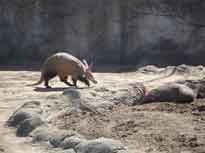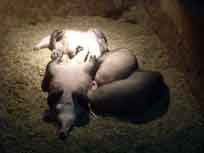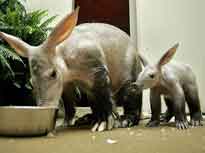Tubulidentata -- Aardvarks : awkwardly attractive "ant-eaters"



Origins
The name Arrdvark means "earth pig"(aarde: earth/ground, varken:pig) in Afrikans. The early Europeans who first saw this creature tended to be a bit hungry for boar you see. Seriously, this creature does look like a pig to someone not heavily schooled in mammal classification. Tubulidentata ( tube-like teeth) is a very old mammalian order and only one species, the aarvark survives to this day. The DNA of the aardvark indicates that it has some real ol' school chromosomes that would perhaps have belonged to the ancestor of all placental mammals.
Physical Characteristics
One of the most distinctive characteristics of the Tubulidentata is (as the name implies) their teeth. Instead of having a pulp cavity, each tooth has a cluster of thin, upright, parallel tubes of vasodentin (a modified form of dentine), with individual pulp canals, held together by cementum. The teeth have no enamel coating and are worn away and regrow continuously.
The aardvark is vaguely pig-like in appearance. Its body is stout with an arched back and is sparsely covered with coarse hairs. The limbs are of moderate length. The front feet have lost the thumb,resulting in four toes but the rear feet have all five toes. Each toe bears a large, robust nail which is somewhat flattened and shovel-like, and appears to be intermediate between a claw and a hoof. Very good for digging out termites. The ears are rather long, and the tail is very thick at the base and gradually tapers. The mouth is small and tubular, typical of species that feed on termites. The aardvark has a long, thin, snakelike, protruding tongue and elaborate structures supporting a keen sense of smell. An aardvark's weight is typically between 40 and 65 kg. An aardvark's length is usually between 1 and 1.3 meters, and can reach lengths of 2.2 meters when its tail (which can be up to 70 centimeters) is taken into account. The aardvark is pale yellowish gray in color and often stained reddish-brown by soil. The aardvark's coat is thin and the animal's primary protection is its tough skin. The aardvark has been known to sleep in a recently excavated ant nest, which also serves as protection.
Geographic Distribution
View Larger Map
Reproduction
Aardvarks only pair during the breeding season; after a gestation period of 7 months, a single cub
weighing around 2 kg is born, and is able to leave the burrow to accompany its mother after only two weeks, and is eating termites at 14 weeks and is weaned by 16 weeks. At six months of age it is able to dig its own burrows, but it will often remain with the mother until the next mating season. Aardvarks can live to be over 24 years old in captivity.
Feeding Habits
The aardvark is nocturnal and is a solitary creature that feeds almost exclusively on ants and termites (formicivore); the only fruit eaten by aardvarks is the aardvark cucumber. An aardvark emerges from its burrow in the late afternoon or shortly after sunset, and forages over a considerable home range encompassing 10 to 30 kilometers, swinging its long nose from side to side to pick up the scent of food. When a concentration of ants or termites is detected, the aardvark digs into it with its powerful front legs, keeping its long ears upright to listen for predators, and takes up an astonishing number of insects with its long, sticky tongue—as many as 50,000 in one night have been recorded. It is an exceptionally fast digger, but otherwise moves fairly slowly. Its claws enable it to dig through the extremely hard crust of a termite or ant mound quickly, avoiding the dust by sealing the nostrils. When successful, the aardvark's long (as long as 30 centimeters) tongue licks up the insects; the termites' biting, or the ants' stinging attacks are rendered futile by the tough skin.
Videos